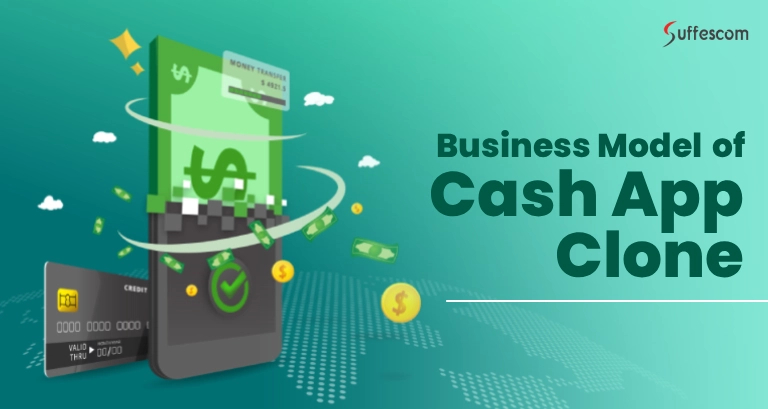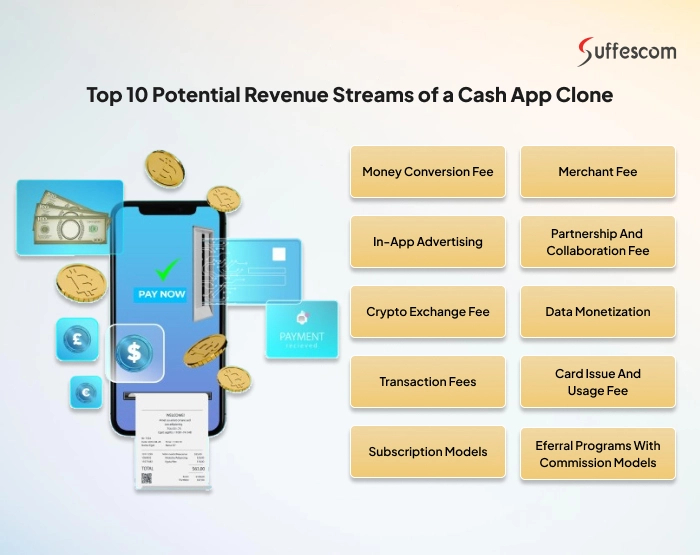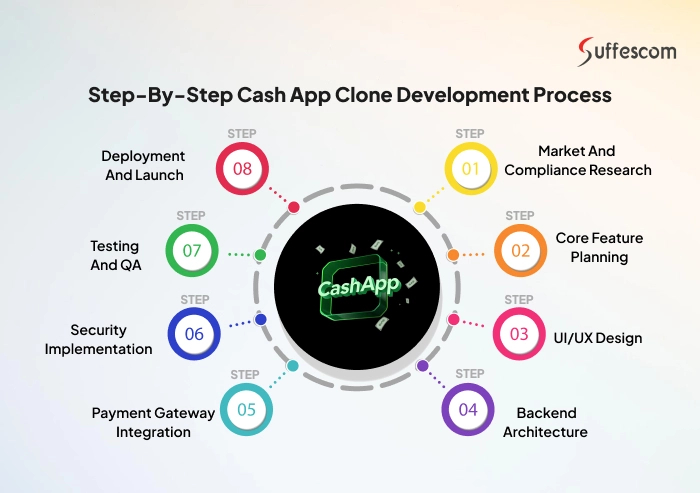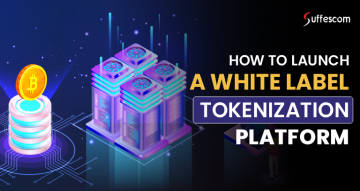Cash App Clone Business Model: Revenue,Features & Development Process

Peer to peer (P2P) payment industry has changed the manner in which we deal with money transfer. Cash App, launched by Block, has set a benchmark by combining quick transactions, investment opportunities, and banking-style services in one app.
For all the entrepreneurs who are aiming at success, it is important to understand the business model of a Cash App clone which is very crucial. This is through its monetizing plan, main functionality, development and cost structure. Beyond replicating features, the actual game is bringing a sustainable revenue machine into being at optimized development costs.
The guide provides a detailed breakdown of the business model, sources of monetization, development process and distinctive market strategies to develop a Cash App clone in the current competitive fintech industry.
Importance of Monetization for Peer-to-Peer Payment Apps
Before diving into the specifics of Cash App clone, it is important to recognize why monetization plays a very important role in supporting P2P payment platforms.
As compared to traditional banks, P2P apps are usually able to provide facilities with a less significant service charge or even free basic facilities to entice the user. This implies that they will have to rely on other sources of earnings.
Why monetization matters:
- The infrastructure such as maintenance of security, compliance and the maintenance of servers needs a consistent revenue action.
- Varied revenue models safeguard the company against a downfall in the market.
- The feature of scalability is achieved through monetization, meaning that the platform has the opportunity to grow in features and reach new markets.
In the case of a Cash App clone, a multi-channel monetization approach is not a possibility, but rather a long-term sustainable success.
Cash App Clone Business Model: Core Framework
Cash App uses the freemium and premium combination model in its functionality. The app allows people to transfer money person to person at no charge, but the app makes money in several ways, both directly and indirectly.
The foundation of its business model lies in:
- User Base Growth: Making payments entirely free, simple and fast to get a huge user base and keep it active.
- Value-Added Services: Crypto trading, stock investments, instant deposits and merchant tools.
- Third Party Partnerships: Partnership with brands, merchants and financial institutions.
- Data Insights: The ability to make offers and use partner deals based on transaction information.
A clone of the Cash App would be advised to use a strategy of wide funnel, high retention, e.g. by making initial entry free but offering paid features and services that can make average revenue per user (ARPU) soar.
Top 10 Potential Revenue Streams of a Cash App Clone

As the P2P market is competitive, it is necessary to integrate several income sources to become outstanding. The most profitable are the following:
1. Transaction Fees
Place a fee on the immediate money transfer into accounts to the users. Such as the Cash App has fees of about 0.5 to 1.75 percent on instant deposits.
How to do it: Provide free (standard) and paid (instant) transfers.
2. Money Conversion Fee
A conversion rate may be used for users who have to deal with multiple currencies.
Example: A user who sends USD to an EUR recipient receives a higher percentage of the exchange rate over the app.
3. Merchant Fee
Allow merchants to add payment through the app, and charge them a certain percentage in payment processing (e.g. 2.5-3 percent).
Key Advantage: Makes merchants willing to add the checkout system to the app.
4. Subscription Models
Add premium subscription plans with a set of benefits, including zero transaction fee or advanced analytics or increased transfer amounts.
Revenue logic: High-consistent monthly or annual income of loyal users.
5. In-App Advertising
Co-brand to advertise specific products according to the spending habits. This is good with cash back or discounts to the users.
6. Partnership and Collaboration Fee
Collaborate with companies in consolidated services such as payment of bills, loans, or insurance. They can charge a commission on the access of customers.
7. Card Issue and Usage Fee
Provide a debit card with a brand associated with the app wallet. Make money through card issuance / replacement and transaction commission.
8. Crypto Exchange Fee
Enable customers to purchase, sell and trade cryptocurrencies. Charge a spread or a consent fee for every trade.
9. Data Monetization
Sell insights based on analysis of anonymized transaction data, to market research companies.
10. Referral Programs with Commission Models
Implement referral schemes whereby users are given rewards for inviting a friend and partner brands pay their customers.
Unique Revenue Ideas to Outshine Competitors
The combination of the above models is tested and proven; nevertheless, there are other concepts you may use to differentiate your Cash App clone:
- Integrated Micro-Investment Platform: Round-up transactions to invest spare change.
- Premium Security Add-ons: Charge a higher value for added fraud protection tools.
- Cross-Border P2P Lending: Systems of providing small peer loans and getting a commission.
Step-by-Step Cash App Clone Development Process

Developing a Cash App clone will take technical and regulatory actions. This is an organized procedure:
Step 1: Market and Compliance Research
Determine the target regions and the rules of fintech.
Research your competitors in order to identify service gaps.
Step 2: Core Feature Planning
Essential features include:
- Instant P2P transfers
- Wallet integration
- QR code payments
- Crypto trading
- Investment tools
- Bank account linking
Step 3: UI/UX Design
- Prioritize simplicity and security.
- Create intuitive navigation for first-time users.
Step 4: Backend Architecture
- Secure server environment
- Scalable cloud infrastructure
- API integrations for payments, KYC, and fraud detection
Step 5: Payment Gateway Integration
- Enable multiple funding sources: bank accounts, debit/credit cards, crypto wallets.
Step 6: Security Implementation
- End-to-end encryption
- Multi-factor authentication
- Fraud detection algorithms
Step 7: Testing and QA
- Functional testing
- Security penetration testing
- Load testing for high traffic
Step 8: Deployment and Launch
- Release on app stores.
- Run pre-launch marketing to build anticipation.
Understanding the Development Cost of a Cash App Clone
The total development cost depends on several key factors, including the specific features you want to include, the complexity of the app’s design and functionality, and the geographic location of the development team. On average, the development cost of a Cash App clone ranges from:
- Basic version: $10,000–$15,000
- Advanced version: $15,000–$20,000
- Enterprise-grade with crypto & investments: $25,000+
Cost drivers include:
- Number of integrated services (crypto, investments, merchant tools)
- Security and compliance requirements
- UI/UX complexity
- Third-party API costs
Cost-Saving Strategies to Invest in a Cash App Clone
For startups with budget limitations, here are proven strategies:
- Start with MVP (Minimum Viable Product): Release the core functions first, and then expand.
- Use White-Label Solutions: It gives a chance to save time and money to develop a solution.
- Outsource Development: Contract with qualified teams in low-cost areas.
- Adopt Open-Source Frameworks: Cut down the licensing fees.
- Cloud-Based Infrastructure: You want to save up front huge expenditures and pay as you grow.
Launch Your Cash App Clone Today!
Get a fully functional, revenue-ready P2P payment app tailored to your business model. Start capturing market share from day one.
Regulatory and Compliance Considerations
Operating a P2P payment platform involves strict compliance, such as:
- KYC (Know Your Customer) verification
- AML (Anti-Money Laundering) compliance
- PCI DSS certification for card transactions
- Data Privacy Laws like GDPR or CCPA
Non-compliance attracts heavy fines and even a ban on operations. This makes it important to ensure that the platform complies with the necessary regulations.
What is the Tech Stack for Cash App Clone Development?
Selecting the right tech stack has a significant impact on security, scalability, and performance.
- Frontend: React Native, Flutter (for cross-platform apps)
- Backend: Node.js, Django, Ruby on Rails
- Database: PostgreSQL, MongoDB
- Payment APIs: Stripe, PayPal SDK, Plaid
- Security: JWT authentication, AES encryption, SSL/TLS
Future Trends in P2P Payment App like Cash App Business Models
To ensure your Cash App clone stays relevant, keep an eye on these trends:
- AI-powered Fraud Detection: Real-time threat identification.
- Biometric Authentication: Fingerprint and facial recognition.
- Decentralized Finance (DeFi) Integrations: Direct crypto lending and staking.
- Voice-Activated Transactions: Using smart assistants for payments.
Marketing Strategies to Scale Your Cash App Clone
Even the most feature-rich app can fail without the right marketing. Strategies include:
- Referral Bonuses: Drive organic growth.
- Influencer Partnerships: Build trust with niche audiences.
- Content Marketing: Educate users about features and security.
- Social Proof & Reviews: Showcase customer feedback.
Build. Scale. Monetize Your P2P Payment App Now.
From development to deployment, we help you create a feature-rich payment solution designed to grow and generate multiple income streams.
Final Thoughts
A Cash app clone can be a high-income fintech solution, if developed with a distinct monetization strategy, compliance with regulatory rules, and features that stand the test of time. Although transaction fees and merchant charges generate the most revenue, the introduction of crypto services, collaboration, and subscription models is one way to significantly increase profitability.
For startups, it is always best to begin lean with an MVP and make continuous improvements based on customer response, eventually adding services later on. Suffescom Solutions is an experienced fintech app development company that combines innovation, compliance, and cost-effectiveness. Get in touch with our experts to get a customized solution for your business.
FAQs
1. How does a Cash App clone make money?
It makes money by receiving transaction fees, charging merchants, offering subscriptions, in-app advertisements, and crypto exchange, and partnerships.
2. What is the cost to build a Cash App clone?
It costs between $10,000 and $25,000+, depending on the features, as a basic platform. The cost can be $30,000 or more as a fully integrated platform.
3. Is it legal to launch a Cash App clone?
Of course, provided you ensure that you meet the regulations in your target market, such as financial regulations for opening bank accounts, including KYC, AML, and data privacy laws.
4. Can I integrate cryptocurrency services into a Cash App clone?
Absolutely. Trading and exchange discovery options can be incorporated to diversify revenue streams.
5. How long does it take to develop a Cash App clone?
It takes 3-4 months on an average to develop the Cash app clone. But the duration can vary based on complexity and feature set.








